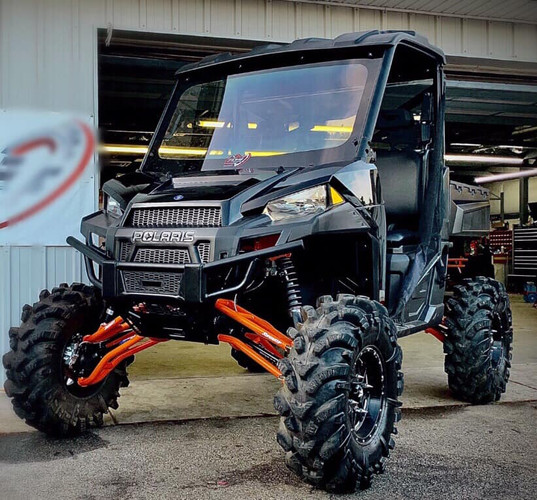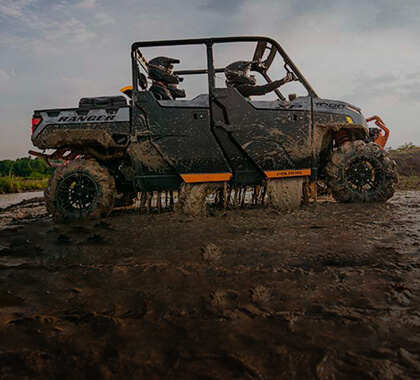Common Problems With The Polaris Ranger High Lifter And How To Solve Them
Dec 22nd 2019

The base model of the Polaris Ranger is good, but the Polaris Ranger High Lifter edition is even better. This “undisputed king of the mud” comes stock with various protective accessories, innovative water draining features, and larger tires that make it perfect for wet and low-traction environments like bogs and muddy trails. But because both the EPS and the non-EPS Polaris Ranger High Lifter are made to be used and abused, it is not surprising that parts and components begin to break down, wear out, and fail completely at a more rapid rate than other Polaris Ranger editions. If you have been an owner of the High Lifter Ranger model for extended periods of time, you’ve likely encountered some type of failure or another. And if this is the case, perhaps we can help by shedding a bit of light on the common issues associated with the Polaris Ranger High Lifter -- as well as how to solve them. Plus, with amazing replacement Polaris Ranger High Lifter parts and components, we here at Everything Polaris Ranger can offer you a full-stack service to get your High Lifter machine back up and running when things go awry.
Problem 1: Rusty High Lifter Differential Splines

One common issue with the Polaris Ranger High Lifter is rust accumulation on the splines with in the rear and front differentials. Because High Lifters are often used as mud machines, this corrosion and mud build-up makes sense. If left to corrode and rust over, the Polaris Ranger High Lifter differential splines become extremely difficult to remove. Luckily, we've helped other riders get through this, and we can help you too!
You might be thinking about pulling the axle and sticking an extension or long punch through the back end to remove the rusty differential splines, but this takes a bit of work, as you have to remove everything and then put it all back together again. Plus, not all years of the Polaris Ranger High Lifter will allow this, as the differentials in some years are sealed with no way to punch them out from the other side.
A good way to deal with rusted-on UTV parts is to soak the crap out of them with PB Blaster or similar Polaris Ranger High Lifter cleaning products. They can be stubborn for sure, and you might have to tap or pull on them with some basic Polaris Ranger hand tools. With regards to rusty Polaris Ranger High Lifter differentials, a slide hammer can applied to the upper arm and used as a pivot to remove the rusted-in components. You could alternatively take a ratcheting tie-down strap and wrap it tightly around the differential cup and the control arm to push the a-arm upward. Hold pressure by pushing down, which will cause the strap to tighten up more (essentially pulling on the cup), and have a buddy use a slide hammer to give it a little happy tap. If all else fails, you can try applying an aerosolized Kroil solution like the Aerokroil product by Kano Laboratories. Penetrating oils like these are a bit costly, but they'll illuminate oils, remove dried grease, dissolve stuck-on gum, and prevent rust.
Problem 2: Vibrations In The Differential Area

On top of rusted-in differential splines, the front differential on the Polaris Ranger High Lifter in general is an area where problems are known to occur. Of the primary problems with the Polaris Ranger High Lifter front differential, vibration is among the worst. Shakiness and vibration often occurs due to bent or out-of-phase driveshafts. A wonky Polaris Ranger High Lifter drive shaft can then cause the pinion bearing to come apart, and this wreaks havoc on the pinion seal. Even if you only notice the vibrations in four wheel drive (4WD), the driveshaft could still be the culprit, as it may only be under load when 4WD is engaged. You can try to replace the carrier bearing, but if the vibrations persist, you should balance or replace your drive shaft.
Problem 3: Breaking Polaris Ranger High Lifter Output Shafts And Snorkel Gears
Even if you’re not using your Polaris Ranger High Lifter for extreme mudding, it is not uncommon to break the snorkel gear or output shaft on land, in light mud, or during creek crossings — especially when backing up under high-torsional loads in reverse. Generally, when you see repetitive part failures, there’s usually a common cause. If the transmission has been rebuilt or replaced, there’s a high probability that gear lash is occurring, where the clearance between mating gear teeth are outside tolerable ranges and rubbing together. If your gears are grinding, some aftermarket parts may help. We know riders that have replaced their output shaft and gear assemblies with aftermarket options by side-by-side companies like Turner. After they made the switch, the folks we talked to experienced zero issues with the Polaris Ranger High Lifter snorkel gears and outputs shafts they bought from us at Everything Polaris Ranger.
Problem 4: Stuttering And Hesitations In Reverse
A number of Polaris Ranger High Lifter owners have contacted us about reverse issues with their rigs. Their HL Rangers hesitate before kicking into gear in low or while reversing, and once the vehicle does begin to accelerate, it spits and sputters sputters erratically. Not only is this annoying, but it can also cause neck injuries and whiplash. What is to blame for this problem you might ask? Well, it's the factory Polaris Ranger High Lifter gear reduction. Like most issues, this one too can be solved with the help of Everything Polaris Ranger. Something as simple as an aftermarket clutch and tune can do the trick, with the Gilomen clutch and tune being a solid option for High Lifter owners to choose.

Gilomen has High Lifter-specific tunes for both the 900 and 1000 Polaris Ranger High Lifter editions. Not only does this help with hesitation and jerkiness, but the power that is unlocked due to the tuned clutch is incredible. No matter if you're running in low gear, at highway speeds, in reverse, uphill, through mud, or just want to punch it to pin your passengers to the back of their seats, the Gilomen clutch kit and tune unequivocally delivers.
Hitting 70 miles per hour on 30” tires is not a problem with an aftermarket Polaris Ranger High Lifter clutch, and the shifting engagement it brings to the table is almost instantaneous. Backing up and parking is noticeably different, with the biggest advantage being that your Polaris Ranger High Lifter will almost always remain within its power band. If you have put bigger tires on your machine, you have probably noticed the lack of power, which is far less than you used to have. But this too is overcome with the clutch kits and other solutions Everything Polaris Ranger offers to fix your Polaris Ranger High Lifter problems!




